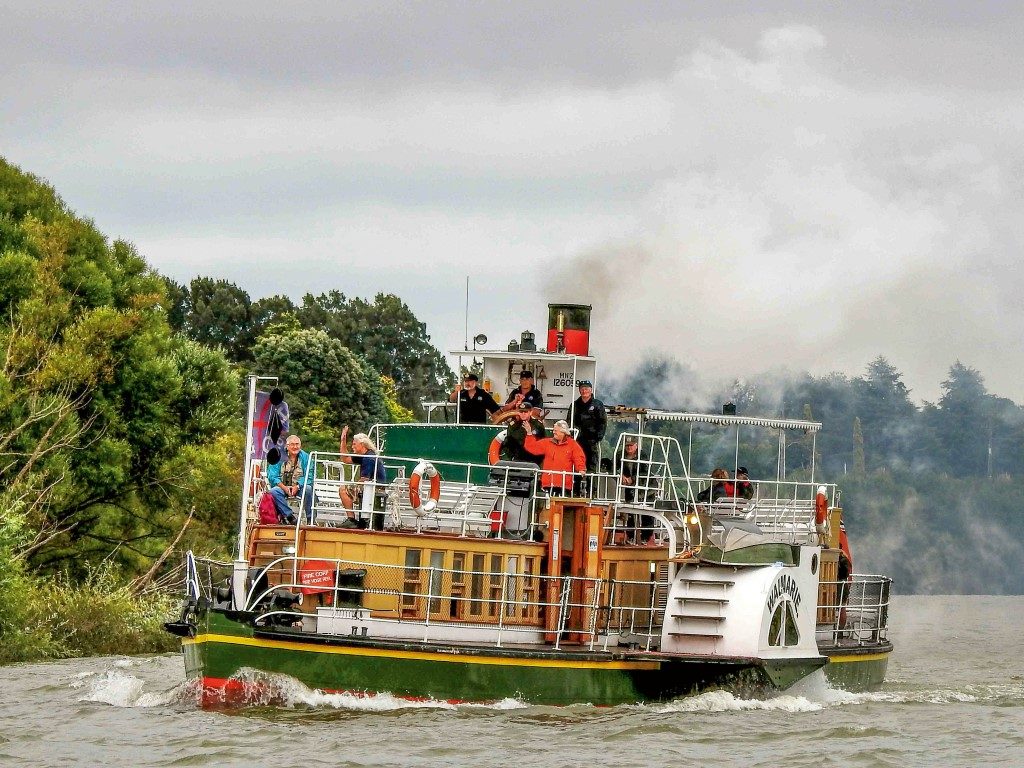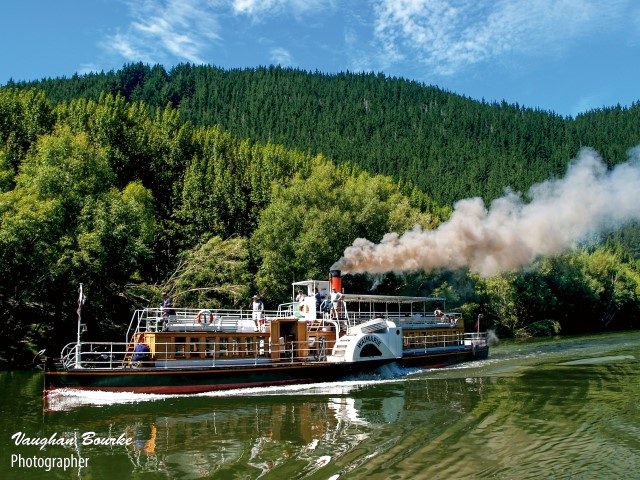

One of Whanganui’s tourism jewels, the Waimarie carries thousands of visitors along the city’s river for an unforgettable cruise every summer. She’s the country’s only operational coal-fired paddle-steamer, but more remarkably, she’s alive after lying in a watery grave for 40 years. Words by Lawrence Schäffler, photography supplied.
To appreciate the magnitude of the Waimarie’s resurrection, you have to rewind to her birth – and her ignominious sinking.
Designed and built in 1899 by Yarrow & Co. Shipbuilders at Poplar, London, her rivetted steel construction was transported in kitset form to Whanganui. Originally named Aotea, she was operated by the Whanganui Settlers River Steamship Co. until 1902, when she was sold to Alexander Hatrick and renamed Waimarie – the name means ‘good fortune – peaceful waters.’

Just after the turn of the century the Whanganui River was something of an international tourism mecca. Waimarie was known as the ‘Queen of the River’ and tourists flocked aboard to experience ‘one of the world’s greatest river journeys’. Making the most of this boom, Hatrick operated a 12-strong fleet of riverboats providing access from the coast to Taumarunui.
With their shallow draught, paddle-steamers were particularly useful for these voyages. At that time the river was not only riddled with shallow, rocky rapids, but vessels also had to negotiate their way through drifting logs and log jams.
Having the broadest beam of all the work boats, Waimarie navigated some 239 rapids carrying a variety of cargo and mail, as well as passengers on scenic excursions. In some of the tricky spots steel cables were used to winch her over the shallows.

The grand lady operated until 1952 when an accident left her listing badly. Before she could be repaired, the river came down in flood and filled her hull with silt. She settled on the bottom and stayed there for the next 40 years.
In 1992 enthusiasts established a community heritage project to salvage, restore and operate the Waimarie. Many thought they were insane but they began acquiring funds, sponsorships, materials, volunteer labour and professional expertise – and the rest is history.
Once extracted from her watery grave, all sorts of salvage treasures came to light – including the starboard navigation light, lamp and whistle. Waimarie’s restoration became Whanganui’s official Millennium Project following seven years of hard work, passion and determination. It absorbed more than 67,000 volunteer-hours from the city’s citizens.

The original design and manufacturing methods were followed as closely as possible, though the restored vessel complies with all modern safety standards. She still boasts covered and open sun decks, two saloons, two toilets and a galley. Her original engines were reconditioned and are still in use. All the hull plates were cold-rivetted – using some 40,000 rivets.
Her original boiler was removed and replaced with a near-identical replica – and it features an unusual design which sees the boiler coming up to pressure in an hour from cold. On the first firing steam was raised from cold to 160psi in 55 minutes. These boilers were originally used in torpedo boats capable of reaching 32 knots.
At 11:45pm on New Year’s Eve, 1999, the Waimarie was blessed with a karakia and re-commissioned for her new life on the Whanganui River. She had been brought back to life 100 years after her original build.
Today, visitors enjoy a more leisurely river cruise appropriate to her stately grace. Cruises and private charters run during summer (October-April).

Waimarie® is a not-for-profit organisation and is operated by the Waimarie Operating Trust Board whose role is to ensure it operates as a financially sustainable, highly regarded premier experience. She is undoubtedly one of the most authentic ways to experience Whanganui River’s scenery and history.
A dedicated team of employees and volunteers work at the nearby Riverboat Centre – a 134-year-old building which originally served (in 1881) as a rowing facility for the Wanganui Rowing Club. Today it’s home to the Riverboat Museum which houses a fascinating display of river-related photographs, artefacts and memorabilia from the last century. BNZ
SPECIFICATIONS Waimarie
gross tonnage 80 tons
lwl 100.2 ft
waterline beam 16 ft
passengers up to 80 (110 for private cruises)
mandatory crew 6
engines 2 x single-cylinder, double acting, noncondensing, inclined horizontal with Gooch valve gear (Yarrow & Co, Poplar, London, 1889)
bore x stroke 9 x 24 inches
cruising speed 6-7 knots (42rpm)
max speed 11 knots (70rpm)
boiler working pressure 160psi (coal consumption 4 cwt/hr)




